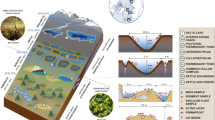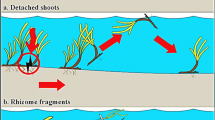Abstract
Glaciers support diverse ecosystems that are largely comprised of microbial life. However, at larger, macroscopic scales, glacier moss balls (sometimes called “glacier mice”) can develop from impurities on ice surfaces and represent a relatively rare biological phenomenon. These ovoid-shaped conglomerations of dirt and moss are only found on some glacier surfaces and provide key habitats for invertebrate colonization. Yet, despite their development and presence being widely reported, no studies of their movement and persistence across years have been conducted. This knowledge gap is particularly important when considering the degree to which glacier moss balls may represent viable, long-term biotic habitats on glaciers, perhaps complete with their own ecological succession dynamics. Here, we describe the movement and persistence of glacier moss balls on the Root Glacier in southcentral Alaska, USA. We show that glacier moss balls move an average of 2.5 cm per day in herd-like fashion initially to the south and later towards the southwest, and their movements are positively correlated with glacier ablation. Surprisingly, the dominant moss ball movement direction does not align with the prevailing wind or downslope directions, nor with the dominant direction of solar radiation. After attaining a mature size, glacier moss balls persist for many years, likely in excess of 6 years. Finally, we observed moss ball formation on the Root Glacier to occur within a narrow, low albedo stripe downwind of a nunatak, a potential key source of moss spores and/or fine-grained sediment that interact to promote their formation.




Similar content being viewed by others
References
Akaike H (1998) Information theory and an extension of the maximum likelihood principle. Selected papers of Hirotugu Akaike. Springer, New York, pp 199–213
Anesio AM, Hodson AJ, Fritz A, Psenner R, Sattler B (2009) High microbial activity on glaciers: importance to the global carbon cycle. Glob Change Biol 15:955–960
Anesio AM, Laybourn-Parry J (2012) Glaciers and ice sheets as a biome. Trends Ecol Evol 27:219–225
Anesio AM, Lutz S, Chrismas NA, Benning LG (2017) The microbiome of glaciers and ice sheets. NPJ Biofilms Microbiomes 3:1–11
Armstrong WH, Anderson RS, Allen J, Rajaram H (2016) Modeling the WorldView-derived seasonal velocity evolution of Kennicott Glacier, Alaska. J Glaciol 234:763–777
Belkina OA, Vilnet AA (2015) Some aspects of the moss population development on the Svalbard glaciers. Czech Polar Rep 5:160–175
Benninghoff WS (1955) Jökla-mýs. J Glaciol 2:514–515
Castro-Santos T, Haro A, Walk S (1996) A passive integrated transponder (PIT) tag system for monitoring fishways. Fish Res 28:253–261
Cook J, Edwards A, Takeuchi N, Irvine-Fynn T (2016) Cryoconite: the dark biological secret of the cryosphere. Prog Phys Geog 40:66–111
Coulson S, Midgley N (2012) The role of glacier mice in the invertebrate colonisation of glacial surfaces: the moss balls of the Falljökull, Iceland. Polar Biol 35:1651–1658
Deevey ES Jr (1947) Life tables for natural populations of animals. Q Rev Biol 22:283–314
Dial RJ, Becker M, Hope AG, Dial CR, Thomas J, Slobodenko KA, Golden TS, Shain DH (2016) The role of temperature in the distribution of the glacier ice worm, Mesenchytraeus solifugus (Annelida: Oligochaeta: Enchytraeidae). Arct Antarct Alp Res 48:199–211
Eythórsson J (1951) Correspondence Jökla-mys. J Glaciol 1:503
Festa-Bianchet M, Gaillard JM, Côté SD (2003) Variable age structure and apparent density dependence in survival of adult ungulates. J Anim Ecol 72:640–649
Ganey GQ, Loso MG, Burgess AB, Dial RJ (2017) The role of microbes in snowmelt and radiative forcing on an Alaskan icefield. Nat Geosci 10:754–759
Gardner AS, Moholdt G, Cogley JG, Wouters B, Arendt AA, Wahr J, Berthier E, Hock R, Pfeffer WT, Kaser G (2013) A reconciled estimate of glacier contributions to sea level rise: 2003 to 2009. Science 340:852–857
Heusser CJ (1972) Polsters of the moss Drepanocladus berggrenii on Gilkey Glacier, Alaska. Bul Torrey Bot Club 99:34–36
Hotaling S, Hood E, Hamilton TL (2017a) Microbial ecology of mountain glacier ecosystems: biodiversity, ecological connections and implications of a warming climate. Environ Microbiol 19:2935–2948
Hotaling S, Finn DS, Joseph Giersch J, Weisrock DW, Jacobsen D (2017b) Climate change and alpine stream biology: progress, challenges, and opportunities for the future. Biol Rev 92:2024–2045
Hotaling S, Shain DH, Lang SA, Bagley RK, Lusha M, Weisrock DW, Kelley JL (2019) Long-distance dispersal, ice sheet dynamics, and mountaintop isolation underlie the genetic structure of glacier ice worms. Proc R Soc B 286:20190983
Hotaling S, Wimberger PH, Kelley JL, Watts HE (2020) Macroinvertebrates on glaciers: a key resource for terrestrial food webs? Ecology 101:e02947
Hurvich CM, Tsai C-L (1989) Regression and time series model selection in small samples. Biometrika 76:297–307
Larsen C, Burgess E, Arendt A, O'neel S, Johnson A, Kienholz C, (2015) Surface melt dominates Alaska glacier mass balance. Geophys Res Lett 42:5902–5908
Lebreton J-D, Burnham KP, Clobert J, Anderson DR (1992) Modeling survival and testing biological hypotheses using marked animals: a unified approach with case studies. Ecol Monogr 62:67–118
Loison A, Festa-Bianchet M, Gaillard J-M, Jorgenson JT, Jullien J-M (1999) Age-specific survival in five populations of ungulates: evidence of senescence. Ecology 80:2539–2554
Mann D, Edwards J, Gara R (1980) Diel activity patterns in snowfield foraging invertebrates on Mount Rainier, Washington. Arct Antarct Alp Res 12:359–368
Millar JS, Zammuto RM (1983) Life histories of mammals: an analysis of life tables. Ecology 64:631–635
Perez FL (1991) Ecology and morphology of globular mosses of Grimmia longirostris in the Paramo de Piedras Blancas, Venezuelan Andes. Arct Antarct Alp Res 23:133–148
Porter P, Evans A, Hodson A, Lowe A, Crabtree M (2008) Sediment–moss interactions on a temperate glacier: Falljökull, Iceland. Ann Glaci 48:25–31
Roe GH, Baker MB, Herla F (2017) Centennial glacier retreat as categorical evidence of regional climate change. Nat Geosci 10:95–99
Rosvold J (2016) Perennial ice and snow-covered land as important ecosystems for birds and mammals. J Biogeogr 43:3–12
Shacklette HT (1966) Unattached moss polsters on Amchitka Island, Alaska. Bryologist 69:346–352
Stibal M, Bradley JA, Edwards A, Hotaling S, Zawierucha K, Rosvold J, Lutz S, Cameron KA, Mikucki JA, Kohler TJ, Šabacká M, Anesio AM (2020) Glacial ecosystems are essential to understanding biodiversity responses to glacier retreat. Nat Ecol Evol. https://doi.org/10.1038/s41559-020-1163-0
Uetake J, Tanaka S, Hara K, Tanabe Y, Samyn D, Motoyama H, Imura S, Kohshima S (2014) Novel biogenic aggregation of moss gemmae on a disappearing African glacier. PLoS ONE 9:e112510
Van der Walt S, Schönberger JL, Nunez-Iglesias J, Boulogne F, Warner JD, Yager N, Gouillart E, Yu T (2014) Scikit-image: image processing in Python. PeerJ 2:e453
Acknowledgements
S.H. was supported by NSF award #OPP-1906015. We thank the Wrangell Mountains Center for logistical support and assisting with field measurements, and Dr. Billy Armstrong for providing the orthoimage of the study area.
Author information
Authors and Affiliations
Corresponding author
Ethics declarations
Conflict of interest
The authors declare no conflicts of interest.
Additional information
Publisher's Note
Springer Nature remains neutral with regard to jurisdictional claims in published maps and institutional affiliations.
Electronic supplementary material
Below is the link to the electronic supplementary material.
Rights and permissions
About this article
Cite this article
Hotaling, S., Bartholomaus, T.C. & Gilbert, S.L. Rolling stones gather moss: movement and longevity of moss balls on an Alaskan glacier. Polar Biol 43, 735–744 (2020). https://doi.org/10.1007/s00300-020-02675-6
Received:
Revised:
Accepted:
Published:
Issue Date:
DOI: https://doi.org/10.1007/s00300-020-02675-6




